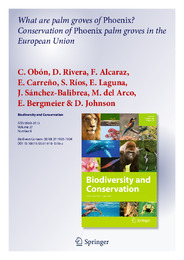Please use this identifier to cite or link to this item:
https://hdl.handle.net/11000/5281Full metadata record
| DC Field | Value | Language |
|---|---|---|
| dc.contributor.author | Obon, Concepcion | - |
| dc.contributor.author | Rivera Núñez, Diego | - |
| dc.contributor.author | Alcaraz Ariza, Francisco | - |
| dc.contributor.author | Carreño Sánchez, Encarnación | - |
| dc.contributor.author | Ríos, S. | - |
| dc.contributor.author | Laguna, E. | - |
| dc.contributor.author | Sanchez‑Balibrea, J. | - |
| dc.contributor.author | del Arco, M. | - |
| dc.contributor.author | Bergmeier, E. | - |
| dc.contributor.author | Johnson, Dennis | - |
| dc.contributor.other | Departamentos de la UMH::Biología Aplicada | es |
| dc.date.accessioned | 2019-09-18T10:51:52Z | - |
| dc.date.available | 2019-09-18T10:51:52Z | - |
| dc.date.created | 2018-02-16 | - |
| dc.date.issued | 2019-09-18 | - |
| dc.identifier.issn | 0960-3115 | - |
| dc.identifier.issn | 1572-9710 | - |
| dc.identifier.uri | http://hdl.handle.net/11000/5281 | - |
| dc.description.abstract | There are three species of Phoenix (Arecaceae) in the territory of the European Union, P. canariensis, P. dactylifera and P. theophrasti, found in wild-native populations, feral, planted and intermediate states, accounting each for thousands of individuals. The EU Habitats Directive has addressed the conservation of P. theophrasti and P. canariensis under the habitat type 9370, ‘Palm groves of Phoenix,’ but neglected to include the wild-growing populations of P. dactylifera palms in southern Spain. In this paper, we survey the habitats and status of both representative native and naturalized populations of Phoenix, in total 103, through fieldwork, image analysis and review of literature. We underline the significance of feral populations and palms originating from ancient abandoned plantations, existing in protected areas as a reservoir of genetic variation. We conclude that, in order to improve their conservation status by adequate protection and conservation management, the concept of Phoenix palm groves in the Habitats Directive should be redefined to include the western group of P. dactylifera and the various habitats of P. canariensis and P. theophrasti that do not appear in the current definition. | es |
| dc.description.sponsorship | This research received, for the Spanish part, support from the projects RF2007- 00010-C03, RF2010-00006-C02, RFP2013-00004-00-00 (INIA, Ministerio de Economia y Competitividad, | - |
| dc.description.sponsorship | European Regional Development Fund 2007-2013, 2014-2020). EB acknowledges the support received during the mapping and monitoring project in Crete funded by the European Union and the Greek Ministry of Environmental Affairs | - |
| dc.format | application/pdf | es |
| dc.format.extent | 22 | es |
| dc.language.iso | eng | es |
| dc.rights | info:eu-repo/semantics/openAccess | es |
| dc.subject | Canary Islands | es |
| dc.subject | Crete | es |
| dc.subject | EU habitats directive | es |
| dc.subject | Greece | es |
| dc.subject | Spain | es |
| dc.subject.other | 58 - Botánica | es |
| dc.title | What are palm groves of Phoenix? Conservation of Phoenix palm groves in the European Union | es |
| dc.type | info:eu-repo/semantics/article | es |
| dc.identifier.doi | 10.1007/s10531-018-1516-z | - |
| dc.relation.publisherversion | https://doi.org/10.1007/s10531-018-1516-z | - |

View/Open:
1-Conservation Phoenix.pdf
1,9 MB
Adobe PDF
Share:
.png)
